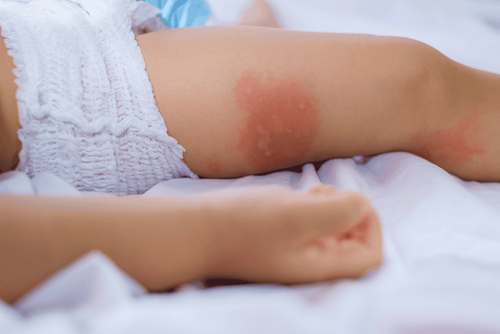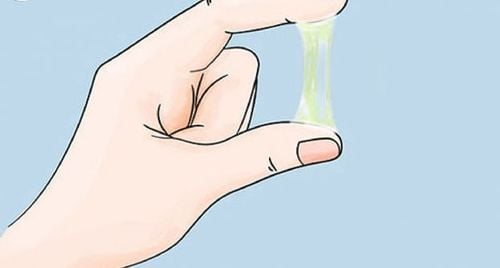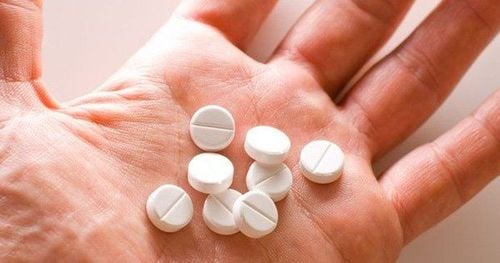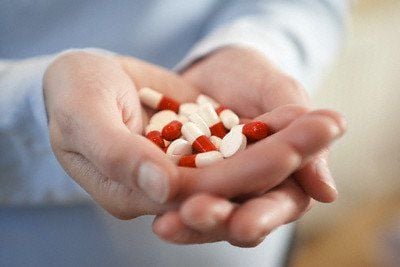This is an automatically translated article.
Types of acne in infants such as vesicles, vesicles, pustules, ... caused by many causes such as congenital diseases, infectious diseases, ... Need timely diagnosis and treatment for conditions above to avoid unwanted sequelae.
1. Learn about common types of infant acne The most common, transient types of infant acne are:
1.1 Newborn Toxic Erythrma (English) Erythema toxicum neonatorum (ETN) is a common pustular disease in about 20% of newborns within the first 72 hours of birth. This condition is common in high-birth-weight infants, full-term or old-term babies. The pathogenesis is unknown, but according to one hypothesis, toxic scarlet fever in neonates is an initial immune response to the invasion of skin parasites into hair follicles.
Manifestations of toxic erythema in newborns are patches, red papules 1 - 3mm in size, rapidly progressing to pustules on a red background. This lesion usually occurs on the trunk - near the extremities, without lesions on the palms and feet. The disease can manifest from the time of birth but usually appears after about 24-48 hours, regressing after about 5-7 days.
The diagnosis for this condition is mainly clinical. Testing is not usually necessary, but if tested, it will include the following methods: Wright staining of pustules, microscopy; blood test or pus culture for bacteria and fungi. The disease regresses spontaneously, so no treatment is required.
1.2 Transient pustular pigmentation in infants This is one of the most common types of neonatal acne. Transient neonatal pustular melanosis (TNPM) has a lower incidence than neonatal toxic erythema. The disease is common in full-term black infants (4-5%), in 0.5% of term Asian infants. Lesions are present at birth, but the pathogenesis is unknown.
Clinical symptoms of the disease have 3 stages:
Stage 1 (at birth): Children develop small blisters and pustules 2-10mm in size on a non-red skin. Blisters and pustules often develop on the chin, forehead, neck, back and buttocks; rarely on the face, chest or palms, soles of the feet; Stage 2: The child has a red rash on the skin, with mild hyperpigmentation, surrounded by scabs due to broken pustules. This manifestation persists for several weeks to several months; Stage 3: The hyperpigmentation fades over a few weeks to a few months. In some cases, children only show signs of hyperpigmentation, no pustules appear.
The diagnosis of transient pustular pigmentation in neonates is mainly clinical. If laboratory tests are performed, Wright pustular staining or histopathological biopsy can be performed. The disease regresses spontaneously, so no treatment is required.

Ban đỏ nhiễm độc ở trẻ sơ sinh là một trong các loại mụn ở trẻ sơ sinh
1.3 Neonatal cephalic pustulosis Neonatal cephalic pustulosis occurs in approximately 20% of infants and is not familial. The cause of the disease is unclear, but it may be due to an inflammatory reaction of the skin to the fungus Malassezia.
Newborn pustules are common in babies 3 weeks old, lesions are pustules, inflammatory papules, no acne core, mainly appearing on the face, especially cheeks and can grow on the head. The disease is usually mild, self-resolving within 4 months, leaving no scars. The disease also does not increase the risk of developing acne in the teenage years.
To treat pustules on the head in babies, parents should pay attention: Wash your child's face daily, avoid using oil-containing products. Use of ketoconazole 2% cream applied twice daily or hydrocortisone 1% applied once daily has been effective in some cases.
1.4 Miliaria Miliaria is one of the most common types of acne in babies and children. The disease is common in hot and humid climates with a prevalence of up to 15%. It is caused by a blockage of the sweat ducts.
Children with Miliaria have lesions on the face, scalp, and interstitium. The disease has 4 main types:
Miliaria crystals: Present in the form of small blisters, thin-walled and non-inflammatory, like dewdrops. The disease may present from birth due to occlusion of the superficial epidermal eccrine ducts; Miliaria rubra (reddish): Occurs due to blockage of epidermal sweat ducts, leading to local inflammatory reactions in the epidermis and dermis, causing the formation of pustules and red papules; Miliaria pustulosa: Formed by local inflammation, presenting as pustules on a red macule similar to Miliaria rubra; Miliaria profunda: Present as papules, pustular papules and skin discoloration, quite rare in children. Miliaria is rare soon after birth but usually develops within the first week after birth. Diseases especially related to hot temperatures: Using heaters, wearing layers of clothing,...
The diagnosis of Miliaria is mainly based on clinical symptoms. The disease does not require specific treatment. Lesions often regress quickly if the child's sweating is reduced by changing the environment to a cooler environment, allowing the child to wear less clothing.
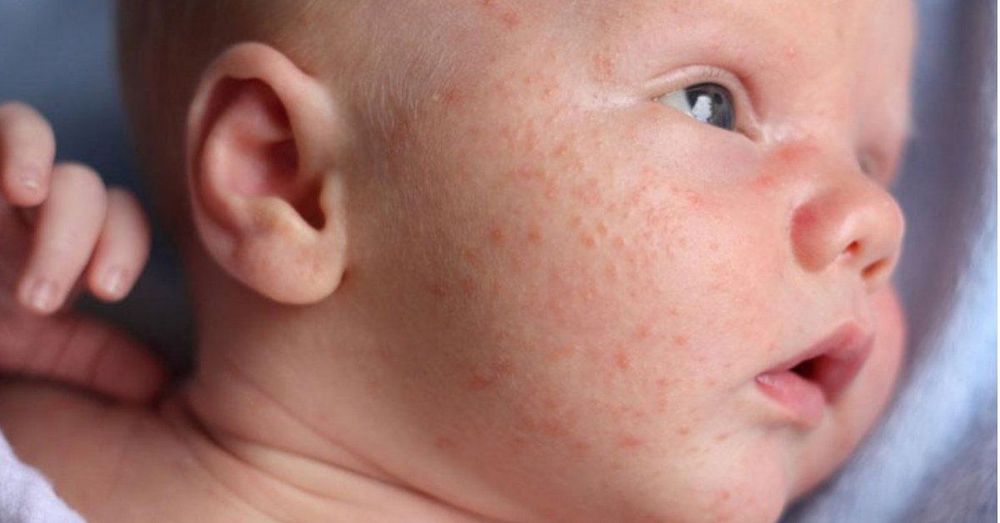
Bệnh Miliaria là một trong các loại mụn ở trẻ sơ sinh và trẻ em thường gặp
1.5 Baby acne Among the types of acne in children, baby acne is an uncommon disease. The disease can occur in babies from a few weeks old to 3-4 months old. The cause of childhood acne is sebaceous gland hyperplasia secondary to androgens - common in boys. In severe, treatment-resistant cases, it is necessary to exclude adrenal tumors, gonadal tumors, congenital adrenal hyperplasia, precocious puberty,...
Symptoms of children's acne are: Classic acne-like lesions with cystic acne, pustules, and inflammatory papules on the face. The disease usually resolves spontaneously within the first year of life but can persist until the child is 3 years old. The disease can recur into severe acne when the child enters puberty.
Treatment of childhood acne is necessary because the disease can leave scars. If the lesions are mild or moderate, the doctor may prescribe mild keratolytics such as 2.5% benzoyl peroxide or topical antibiotics (clindamycin, erythromycin) or topical retinoids. With severe inflammatory lesions, the doctor may prescribe for the child to use isotretinoin, oral erythromycin (do not use tetracycline for children under 8 years old).
2. Rare types of infant and child acne There are several types of acne in babies and children that are quite rare such as:
2.1. Eosinophilic pustular folliculitis in children English name for this disease is Eosinophilic pustular folliculitis of infancy – EPFI. This is a rare skin disease, the pathogenesis is not clear. The relationship between this disease and eosinophilic pustular folliculitis in adults is unknown.
Manifestation of the disease is the appearance of pustules, itchy, recurrent hair follicles, often on the scalp or extremities. The mean age of onset was 5 months old, the male/female ratio was 4/1. Recurrence episodes are usually spaced 1 to 12 weeks apart and resolve spontaneously within 1 to 4 weeks. The disease usually resolves completely by the time the child is 3 years old.
The diagnosis includes: Based on clinical symptoms and laboratory tests. Test methods performed include: fresh pustules, biopsy histopathology and blood test. The disease is treated to relieve symptoms: Using topical corticosteroids to help the lesions heal faster and reduce itching.
2.2. Pustules on the extremities in children This disease has the English name Infantile acropustulosis – IA. This is a benign pustular, vesicular disease that can be chronically progressive. The pathogenesis is unknown, which may be related to a nonspecific hypersensitivity reaction to scabies infection. Co-morbidity with atopic dermatitis occurs in 50% of cases. Pustules on the extremities in children are common in black boys, starting when the child is less than 1 year old.
Clinical manifestations of extremity pustules in children are the appearance of vesicles, pustular itching, or recurrence. Acne spots are mainly on the palms and feet, can appear on the back of the hands, feet, and extremities. The recurrence of acne is usually about 2-4 weeks apart, can last 5-10 days/period. The disease usually resolves within 2 years.
Pustules of the extremities in children are diagnosed based on clinical symptoms. The doctor will look for previous manifestations of scabies, combined with taking the child's family history. The definitive test is a histopathological biopsy (usually not necessary). Treatment options include: Using topical corticosteroids or oral antihistamines, dapsone, erythromycin,...

Mụn mủ vùng đầu ở trẻ sơ sinh
2.3. A vesicular, pustular rash and transient myeloproliferative disorder in children with Down syndrome Approximately 20% of children with Down syndrome have transient myeloproliferative disorders. In some cases, transient myeloproliferative disorder may be accompanied by a vesicular, pustular rash on the face (appearing in the first few days after birth). Skin lesions usually resolve spontaneously after 1-3 months.
2.4. This disease has the English name Incontinentia pigmenti. This is one of the rare types of baby acne. The disease usually appears from birth to a few weeks old. Common lesions are thickened papules, vesicles, growing on the extremities.
2.5. Pustular psoriasis This condition is known in English as Pustular psoriasis. Pustular psoriasis usually appears in babies born 1-7 days. The basic lesions are the appearance of pustules, pustules on a red background. Acne can spread in any position or meet on the palms, soles, ... This is a relatively difficult disease to treat.
2.6. Congenital Langerhan's histiocytosis. The disease has the English name Congenital Langerhans cell histiocytosis. The disease is common in newborn babies or within a few days after birth, with lesions such as papules, vesicles, cysts, petechiae, etc. Acne spots are distributed in any location on the body, and are common. in folds, scalp, palms, soles, mucous membranes,...
Need to examine organs such as liver, kidneys, muscles - bones - joints. If there is only a single skin lesion, the disease usually resolves spontaneously after a few weeks or months, the prognosis is good. In the case of multi-organ damage, the prognosis is worse, requiring systemic treatment.
2.7. Neonatal Behcet's disease in infants The English name of the disease is Neonatal Behcet's disease. Behcet's disease usually appears in babies 1-7 days old, manifests as blisters, pustules, itching or death on the skin of the hands and feet, accompanied by ulcers in the mouth and genitals. Braiding may be accompanied by symptoms such as diarrhea, vasculitis.
2.8. Hyper-IgE syndrome The English name for this condition is Hyper-IgE syndrome. It is an abnormal inflammatory response that occurs from birth to a few weeks of age. Manifestations of the disease are the appearance of vesicles or pustules alone or in groups. Common places where blisters and pustules appear are the face, scalp, armpits, trunk, groin,... Children with increased blood IgE (over 2000 IU/ml), increased eosinophils.
There are many diseases that cause acne in babies and children. Some diseases resolve on their own, but some diseases can be accompanied by multi-organ damage, complicated treatment. Therefore, when the child has abnormal skin manifestations, parents should take the baby to the doctor soon for an accurate diagnosis and timely treatment.
Please dial HOTLINE for more information or register for an appointment HERE. Download MyVinmec app to make appointments faster and to manage your bookings easily.




